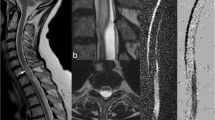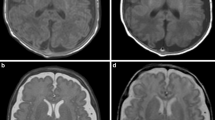Summary
The variations of the relative signal intensity and the time dependent changing contrast of intracranial hemorrhages on high-field spin-echo magnetic resonance images (MRI) were studied in 28 pediatric patients. For T1-weighted images, a repetition time (TR) of 500 ms and an echo time (TE) of 30 or 23 ms was used. The corresponding times for T2-weighted images were TR 3000 ms and TE 120 ms. Intracranial hematomas, less than 3 days old, were iso- to mildly hypointense on short TR/TE scans and markedly hypointense on long TR/TE scans (acute stage). In the following four days the signal of the hematomas became hyperintense on short TR/TE scans, beginning in the periphery and proceeding towards the center. On long TR/TE scans the signal remained markedly hypointense (early subacute stage). 7–14 days old hematomas were of high signal intensity on short TR/TE scans. On long TR/TE scans they appeared hypointense in the center and hyperintense in the periphery (late subacute stage). By the end of the second week the hematomas were of high signal intensity on all pulse sequences (chronic stage). Chronic hematomas were surrounded by a parenchymal rim of hypointensity on long TR/TE scans. 28 neonates and infants (with 11 follow-up examinations) of 31.5–70.6 weeks postconceptional age (PCA), with an intracranial hemorrhage were examined. The etiologies of the hemorrhages were: asphyxia (17 cases), brain infarct (2), thrombocytopenia (1), clotting disorder (1) and unknown origin (7). The aim of this study was to describe the appearance of intracranial hemorrhages inneonates and infants with MRI at2.35 Tesla using spine-cho sequences.
Similar content being viewed by others
References
Bradley WG (1986) MRI of hemorrhage and iron in the brain. In: Stark DD, Bradley WG (eds) Magnetic resonance imaging. Mosby, St Louis, pp 359–374
Dooms GC, Uske A, Brant-Zawadski M, Kucharczyk W, Lemme-Plaghos L, Newton TH, Norman D (1986) Spin-echo MR imaging of intracranial hemorrhage. Neuroradiology 28: 132–138
Gomori JM, Grossman RI, Steiner I (1988) High-field magnetic resonance imaging of intracranial hematomas. Is J Med Sci 24: 218–223
Grossman RI (1988) MR highlights hemorrhage but can be misleading. Diagn Imag Int (November):54–57
Zimmerman RD, Heier LA, Snow RB, Liu DP, Kelly AB, Deck MD (1988) Acute intracranial hemorrhage: intensity changes on sequential MR scans at 0.5 T, AJNR 9:47–57
McArdle CB, Richardson CJ, Hayden CK, Nicholas DA, Crofford MJ, Amparo EG (1987) Abnormalities of the neonatal brain: MR Imaging. Part I. Intracranial hemorrhage. Radiology 163:387–394
Boesch Ch, Martin E (1988) Combined application of MR imaging and spectroscopy in neonates and children — Installation and operation of a 2.35-T system in a clinical setting. Radiology 168:481–488
Boesch Ch, Luescher K, Brunner P, Kewitz G, Martin E (1988) Monitoring and intensive care of premature neonates and children in a 2.35 Tesla spectroscopy and imaging system (abstr.). In: Book of abstracts, vol 2. 7th Annual Meeting of the Society of Magnetic Resonance in Medicine, San Francisco, p 673
Martin E, Kikinis R, Zuerrer M, Boesch Ch, Briner J, Kewitz G, Kaelin P (1988) Developmental stages of human brain: an MR study. J Comp Assisted Tomogr 12:917–922
Gomori JM, Grossman RI, Goldberg HI, Zimmerman RA, Bilaniuk LT (1985) Intracranial hematomas: imaging by high-field MR. Radiology 157:87–93
Gomori JM, Grossman RI, Hackney DB, Goldberg HI, Zimmerman RA, Bilaniuk LT (1987) Variable appearance of subacute intracranial hematomas in high-field spin-echo MR. AJNR 8:1019–1026
Barkovich AJ, Atlas SW (1988) Magnetic resonance imaging of intracranial hemorrhage. Radiol Clin North Am 26:801–820
Stryer L (eds) (1988) Biochemistry, 3rd edn. Freeman and company. New York, pp 143–176
Holland BA, Haas DK, Norman D, Brant-Zawadski M, Newton TH (1986) MRI of normal brain maturation. AJNR 7:201–208
Taber KH, Williamson M, Hayman LA, Orrison WW (1990) Brain hemorrhage at 0.064 T (abstr.). In: Book of abstracts, vol 2. 9th Annual Meeting of the Society of Magnetic Resonance in Medicine, New York, p 647
Fobben ES, Grossman RI, Atlas SW, Hackney DB, Goldberg HI, Zimmerman RA, Bilaniuk LT (1989) MR characteristics of subdural hematomas and hygromas at 1,5T. AJR 153: 589–595
Author information
Authors and Affiliations
Rights and permissions
About this article
Cite this article
Zuerrer, M., Martin, E. & Boltshauser, E. MR imaging of intracranial hemorrhage in neonates and infants at 2.35 Tesla. Neuroradiology 33, 223–229 (1991). https://doi.org/10.1007/BF00588222
Received:
Issue Date:
DOI: https://doi.org/10.1007/BF00588222




